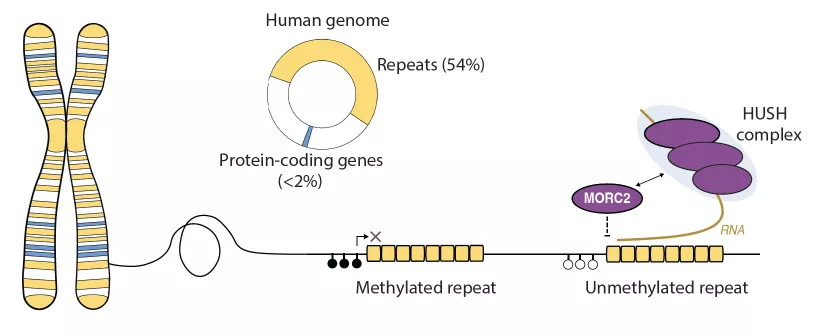The human genome contains large stretches of repetitive DNA, making up over half of its total content. For decades, these regions were dismissed as junk, with little understanding of their purpose or function. But increasingly research is showing that these repetitive sequences are active at different stages of development, and their activity is associated with multiple disorders.
“We’re fascinated by these weird and wonderful parts of our genomes,” says Dr. Christopher Douse, head of the Epigenetics and Chromatin Dynamics research group at Lund Stem Cell Center. “Once disregarded as silent and non-functional, there is more and more evidence that repeats are significant players in human health and disease.”
How the Genome Defends Itself
Repetitive DNA sequences, including viral-like sequences called retrotransposons, pose a threat to genomic stability if left unchecked. They can jump to different locations in the genome, potentially disrupting important genes or regulatory processes. To counteract this, our cells use DNA methylation—a chemical process that silences these elements and prevents them from becoming active.
However, this protective mechanism can weaken during critical stages of life such as early development, aging, or in certain diseases. When DNA methylation falters, the repetitive genome becomes vulnerable.
In their latest study, Christopher Douse and his team, in collaboration with other scientists at Lund Stem Cell Center, identified an important "second line of defense" against these threats: the Human Silencing Hub (HUSH) complex and its partner protein, MORC2.
“Previously, we and others had found that the HUSH-MORC2 system is an essential regulator of retrotransposons,” explains Christopher Douse. “MORC2 binds to retrotransposon DNA and prevents its uncontrolled transcription—but it was unclear how this system worked alongside DNA methylation.”
The Guardians of the Genome – HUSH and MORC2
Using neural progenitor cells to model early brain development, the researchers uncovered how the HUSH complex and MORC2 act when DNA methylation levels drop. The team used genetic editing and new chromatin mapping tools to manipulate and evaluate DNA methylation in these cells, allowing them to observe the HUSH complex's protective role in action.
Their results showed that when DNA methylation falters, the HUSH complex and MORC2 step in to silence repetitive elements, maintaining the stability of the genome. Without this backup mechanism, the repetitive sequences could become active and lead to genome instability.
“You can think of DNA methylation as a rule saying, ‘no loud music after a certain time,’” Christopher Douse explains. “When that rule is broken, and you’re trying to sleep, you might put in earplugs. The HUSH complex acts as those earplugs, keeping the system quiet and stable when the main mechanism fails.”
Broader Implications for Health and Disease
The backup defence system provided by HUSH and MORC2 could also play a role in other conditions where genomic instability occurs. “Our study provides a model for how HUSH and MORC2 function, not just in the brain but likely in other tissues as well," Christopher Douse states. "This understanding could have broader implications for processes that allow repeats to become active like aging, where DNA methylation naturally decreases, and for diseases like cancer, where DNA methylation is often altered.”
The researchers also note that mutations in the MORC2 gene have been shown to cause severe neurodevelopmental disorders. “Our study suggests that the repetitive genome may not be properly controlled in patients with MORC2 mutations, which could lead to problems during brain development,” says Christopher Douse. “This is an area we are now researching to better understand the root causes of these disorders.”
Looking ahead, the research team is planning further investigations and collaborations to dive deeper into how these genome defence mechanisms work.
“This work was a team effort and was only made possible through the close collaborations and leading expertise available at Lund Stem Cell Center,” concludes Christopher Douse. “We’re just beginning to scratch the surface of how these mechanisms work together. There’s still so much to learn, but now we have a framework to guide our next steps.”






